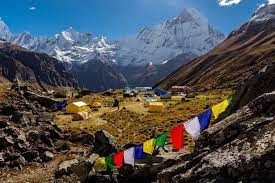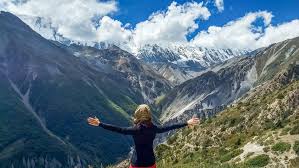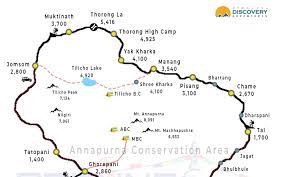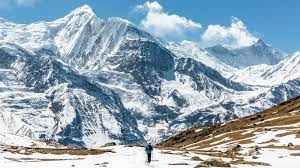Description
Annapurna Circuit Trek is one of those renowned trekking routes in the mountain region of Nepal. This iconic trail draws adventurers, trekkers, and environment lovers from all over the world. The Annapurna Circuit Trek, with its beautiful natural scenery, various cultures, and hard terrains, gives a remarkable experience for those who seek both physical and spiritual discovery.
The Annapurna Circuit Trek typically covers a total distance of around 160-230 kilometers (100-145 miles), depending on the route followed. The trail usually begins in Besisahar and concludes in the towns of Jomsom or Nayapul. Along the way, trekkers cross the gurgling river valleys encircling the beautiful Annapurna range. The peak point of this mesmerizing trek is Thorong La pass with an elevation of 5,416 meters (17,769 feet). Trekkers must be energetic and acclimatized to the high altitude, and also prepared for the unpredictable weather that can occur in the mountains.
Trekkers are certain to come across lush subtropical forests, charming towns, gushing waterfalls, and towering snow-capped peaks like as Annapurna I, Annapurna II, Annapurna III, Annapurna IV, and Dhaulagiri. The trek route passes through villages inhabited by various ethnic groups, including Gurung, Thakali, and Manangi people, allowing you to experience the local communities' rich cultural heritage, traditions, and lifestyles.
Annapurna Circuit Trek is a must-do adventure for trekking enthusiasts and nature lovers seeking a unique and unforgettable experience in the Himalayas.
Major Highlights
The Annapurna Circuit Trek is famous for its amazing scenery and cultural richness, and it provides you with a plethora of highlights and attraction points along the way.
- Thorong La Pass : Rising at the height of 5,416 meters (17,769 feet), Thorong La Pass is the summit point of the journey. It opens up panoramic views of the nearby peaks and mountains and acts as a challenging but rewarding milestone for you.
- The Annapurna Range : The Annapurna mountain range, including Annapurna I, Annapurna II, Annapurna III, and Annapurna IV peaks, presents trekkers with awe-inspiring views of some of the world's highest and most majestic peaks, creating a picturesque backdrop throughout the journey.
- Muktinath Temple :Muktinath Temple, a sacred pilgrimage site lying in the Annapurna Circuit holds religious significance and attracts spiritual devotees from all over the world.
- Kali Gandaki Gorge : The Kali Gandaki Gorge, one of the world's deepest gorges, provides ypu with an astonishing natural spectacle. The gorge is surrounded by the majestic mountains of Dhaulagiri and Annapurna, making a perfect spot for an unforgettable trekking adventure.
- Manang and Marpha Villages: Manang and Marpha are famous villages rich in ethnicity, lying at the laps of beautiful mountains. Marpha Village, renowned for its apple orchards and Thakali culture, and Manang Village, an acclimatization stop in the trans-Himalayan region, offer unique cultural and ecological experiences.
- Natural HotSprings: There are natural hot springs along the trail that provide you with an appropriate relaxation. These hot springs provide a pleasing experience and a chance to rejuvenate tired muscles while surrounded by the peacefulness of the Himalayan landscape.
- Diversity in Landscapes: The Annapurna Circuit Trek flaunts a diverse range of natural environments, from lush green forests and terraced fields to arid landscapes and high-altitude deserts, offering you an ever-changing and appealing trip through the heart of the Himalayas.
Detailed Itinerary
Explore our comprehensive day-by-day itinerary to discover the
highlights and activities planned for each day of your trek.
Day 1 Kathmandu to Chamje
The Annapurna Circuit Trek begins with a drive from Kathmandu to Besishahar on the first day. It takes about 6-7 hours to drive 185 kilometers. The journey follows the Prithvi Highway, a lovely route with views of terraced crops, rivers, and lush hills. The route is bumpy and muddy in some places, but the drive is still fun.
After arriving in Besishahar, you will board a local jeep or bus to Chamje, which is another 2-3 hours away. The route is winding and narrow, with high cliffs on one side and a roaring river on the other. For some, the drive can be nerve-racking, but the scenery is breathtaking. Along the trip, you'll see little villages, suspension bridges, and waterfalls.
Chamje is a small settlement at an elevation of 1,410 m/4,625 ft. It is the trek's starting point, and you will spend the night here. There are simple lodges and tea houses in the village where you can rest and acclimate to the altitude.
Day 2 Chamje to Dharapani
The Annapurna Circuit Trek's second day starts early in Chamje with breakfast and then entails a tough ascent to Tal village (1,700 m/5,577 ft).
The trail continues through several tiny settlements after Tal, then levels out and gets gentler. You'll pass by traditional Nepalese houses, agricultural fields, and maybe some wildlife like birds and monkeys.
You will hike from Bagarchhap to Dharapani, where you will spend the night, for the last part of the day. This section of the trail winds through the forest, following the Marsyangdi River, and is quite simple. The rudimentary facilities of Dharapani include shops, teahouses, and lodges.
Day 3 Dharapani to Chame
The trek's third day starts early in the morning with an ample breakfast. The present-day trekking route is very moderate, passing through deep forests and beautiful scenery.
The trail begins climbing from Dharapani and then bottoms out and descends through dense forests of pine and rhododendron. The trail widens as the hike goes on, providing magnificent views of the Manaslu and Annapurna mountain ranges. After there, the trail passes through a number of scenic valleys to arrive to Chame village, which is Manang's district headquarters.
The lively village of Chame is host to a number of stores, inns, and eateries. Trekkers are advised to enjoy some time exploring the community and mingling with the residents. In addition, they can go to the nearby hot springs outside of town.
Day 4 Chame to Pisang
You will pass through charming little villages with traditional Tibetan architecture and pine and oak woodlands on today's trip. To get to the settlement of Telekhu, you will first need to cross a bridge across the Marsyangdi River and climb up the valley. After that, there will be a sharp hike to a ridge where you will be rewarded with amazing views of Pisang Peak and Annapurna II.
Before you reach Pisang, you will travel through numerous towns as well as other rivers. This village has a beautiful monastery with intricate paintings and statues at the foot of a hill. Additionally, you can stroll around the town and socialize with the kind and friendly residents.
You will spend this evening in a Pisang teahouse, where you may take in the homey ambiance and tasty meals before settling for the evening.
Day 5 Pisang to Manang
We resume our journey today, covering about six hours, from Pisang to Manang. We have a long walk ahead of us today, so we set off early in the morning. We also get to witness amazing views of the Annapurna and Gangapurna mountain ranges while traveling.
We end up in the beautiful town of Manang, which is situated at an elevation of 3,540 meters, after a long journey. This town is well-known for its distinct customs and culture. We can look around the community and go to its monasteries and historic temples. Additionally, we can converse with the people and discover more about their way of life.
Day 6 Acclimatization day in Manang
Any trekker visiting the Annapurna Circuit route will need an acclimatization day in Manang. To avoid altitude sickness and acclimate to the high altitude, it is essential to spend a minimum of one day in Manang.
Manang village provides amazing panoramas of the surrounding hills including the Annapurna range. The village is an excellent location to learn about Tibetan-Buddhist culture as it is home to numerous monasteries and chortens.
Trekkers typically go on a quick hike to a higher elevation on an acclimatization day to help them adjust to the altitude. Hiking options include reaching Gangapurna Lake or reaching the viewpoint above the settlement, which provides wonderful Annapurna views.
Day 7 Manang to Yak Kharka
We will depart Manang today and travel to Yak Kharka, 13,485 feet/ 4,110 meters above sea level. The walk will last three to four hours, covering nine kilometers.
We will be greeted with amazing vistas of the Annapurna mountain range along the route, which includes Gangapurna, Annapurna III, and Tilicho Peak. We will also get a glimpse of the spectacular rock structures that comprise the Thorong La Pass, which we will be crossing in the coming days.
Yaks graze on the slopes as we go closer to Yak Kharka, where the landscape gets more barren. In order to recover and adjust to the high altitude before continuing our journey, we will spend the night in a tea house in Yak Kharka.
Day 8 Yak Kharka to Thorong Phedi
We'll carry on walking today in the direction of the high-altitude Thorong Phedi. Starting at Yak Kharka, the trail climbs sharply across rocky terrain. The path follows the river and goes through plenty of farms. We'll climb up to the village of Ledar gradually.
We'll keep climbing from Ledar in the direction of Thorong Phedi. We will have to cross a couple suspension bridges across rivers as the trail winds through a small canyon. The closer we go to Thorong Phedi, the steeper the climb gets. After eating an early lunch, we'll relax and spend the remainder of the day getting used to the higher altitude.
Located at the foot of the Thorong La Pass is the little community of Thorong Phedi. Trekkers who plan to attempt the summit the next day often use it as a popular area to rest. There are a few lodges and general storefronts in the village. After spending the night in one of the lodges, we will get ready for the tough hike across the Thorong La Pass.
Day 9 Thorong Phedi - Thorong La Pass - Muktinath
Today marks our arrival at Thorong La Pass, the highest point of the Annapurna Circuit Trek, which is situated at a height of 5,416 meters (17,769 feet). We leave early in the morning, between four and five o'clock, in order to beat the wind and get to the pass before it gets too late. The trail is difficult and steep in the beginning, but as we climb higher and higher, the views of the surrounding peaks are increasingly spectacular.
We move slowly and steadily, drinking plenty of water and resting when necessary. Breathing becomes difficult in the last stretch leading up to the pass because of the steep inclines and thin air. But it's all worthwhile when you reach the pass and get to see the breathtaking views of the Himalayan range.
We relax for a while and enjoy the scenery before beginning our descent in the direction of Muktinath. The terrain is first rocky and steep, but as we descend, it gets progressively easier. We go by the little community of Chabarbu, which is well-known for its period-appropriate stone homes and stunning vistas of the Dhaulagiri mountain range.
Day 10 Muktinath to Marpha
The tenth day of the walk begins today, and we will be heading towards Marpha, which is 2670 meters, or 8760 feet, above sea level. We'll need about six or seven hours to do the hike.
We shall leave Muktinath early in the morning, having had breakfast. We will be descending for the most of the walk due to the steepness of the trail to Marpha. We follow the path through the valley of the Kali Gandaki river, which is renowned for its powerful winds.
Apple orchards can be seen along the popular trail to Marpha. Some of the greatest apples in Nepal are produced in Marpha. We'll get to sample some of these delectable apples and take in the breathtaking views of the surroundings.
Day 11 Marpha to Lete
We will be trekking from Marpha to Lete today, which is 2,480 meters (8,135 feet) above sea level. The hike will take about six or seven hours in total.
We begin our hike by making our way down to the Kali Gandaki River, which we cross across on a suspension bridge. After that, we walk down the river's western bank past the charming community of Tukuche, which provides a stunning view of the Annapurna and Dhaulagiri mountains.
We carry on walking toward Lete, a little village encircled by beautiful trees, after lunch. The village is well-known for its magnificent waterfalls and beautiful views of the Dhaulagiri and Annapurna mountain ranges.
Day 12 Lete to Tatopani
It is the twelfth day of our walk, and we are going to Tatopani from Lete. We'll be trekking for around five to six hours today, and we'll cover about fifteen kilometers. From the 2,440-meter-high Lete hamlet to Tatopani, which is 1,200 meters above sea level, the majority of today's journey is downhill.
The natural hot springs that greet us as we get closer to Tatopani are thought to have therapeutic potential. We may unwind by relaxing in the hot springs after an intense day of hiking. We may enjoy fresh apples and apple pies at Tatopani, which is also well-known for its apple orchards.
Day 13 Tatopani to Ghorepani
Our journey from Tatopani to Ghorepani will begin today. It will take us about seven or eight hours to walk the seventeen kilometers.
The ascent to 3,210-meter-high Poon Hill will be the main attraction of today's hike. This is one of the ideal places to stand and take in the amazing views of the Dhaulagiri and Annapurna mountain ranges. From here, we will also be able to witness the sunrise, which is a really captivating sight.
We shall stay at Poon Hill for a while before moving on to Ghorepani. After passing through a number of tiny settlements and waterways, we will arrive in Ghorepani in the evening.
Day 14 Hike to Poon Hill and then trek to Tadapani
You will rise early on the fourteenth day of your trek in the Annapurna region so as to start hiking to Poon Hill. When you get to Poon Hill, you can see the sun rising over the Dhaulagiri and Annapurna mountain ranges, illuminating the surrounding area with a golden hue. You will never forget this event, which is truly once in a lifetime.
You will hike down to Tadapani, a lovely village surrounded by thick trees and breathtaking views of the mountains, after taking in the sunrise vista. The five to six-hour hike from Poon Hill to Tadapani is primarily downhill with some difficult terrain. You will see some of the local wildlife and pass through charming villages along the way.
Day 15 Tadapani to Ghandruk
We head for Ghandruk, one of the major Gurung villages in the Annapurna region, after spending a restful night in Tadapani. The trail offers amazing vistas of the Annapurna and Machhapuchhre (Fishtail) peaks as it descends through a thick forest of rhododendron, oak, and maple trees. Along the trip, there will be a few small streams and waterfalls that we will cross.
The traditional Gurung dwellings in Ghandruk await us, exquisitely adorned with prayer flags and detailed wood carvings. We can take a tour of the village and discover more about the Gurung people's customs and culture.
From our hotel or guesthouse in Ghandruk, we can take in the expansive views of the Annapurna and Machhapuchhre peaks in the evening.
Day 16 Ghandruk to Pokhara
It takes about four to five hours to finish the comparatively easy, downhill trip from Ghandruk to Nayapul. Beautiful terraced fields and small villages can be seen as the trail descends, providing amazing views of the Machhapuchhre (Fishtail) and Annapurna ranges.
After arriving at Nayapul, you have one of two options for transportation: bus or cab. Pokhara is one to two hours' drive away. Pokhara, a beautiful town beside a lake, is a well-liked travel destination in Nepal. In Pokhara, there are a plethora of lodging options, dining establishments, and things to do, like go boating on Phewa Lake, touring the International Mountain Museum, or enjoying a majestic helicopter ride over the Himalayas.
All things considered, the walk from Ghandruk to Nayapul and the drive to Pokhara are wonderful ways to complete your Annapurna Circuit trip and take in the Himalayan scenery and Nepalese culture.
Day 17 Back to Kathmandu
Depending on traffic and road conditions, it can take six to seven hours to travel from Pokhara. You will be viewing spectacular views of Nepal's mountains, rivers, and valleys as you journey through its lovely countryside.
While you enjoy the sights and sounds of Nepal's countryside, the drive back to Kathmandu can be a lovely and unforgettable experience overall. Be careful, and relish the trip.



